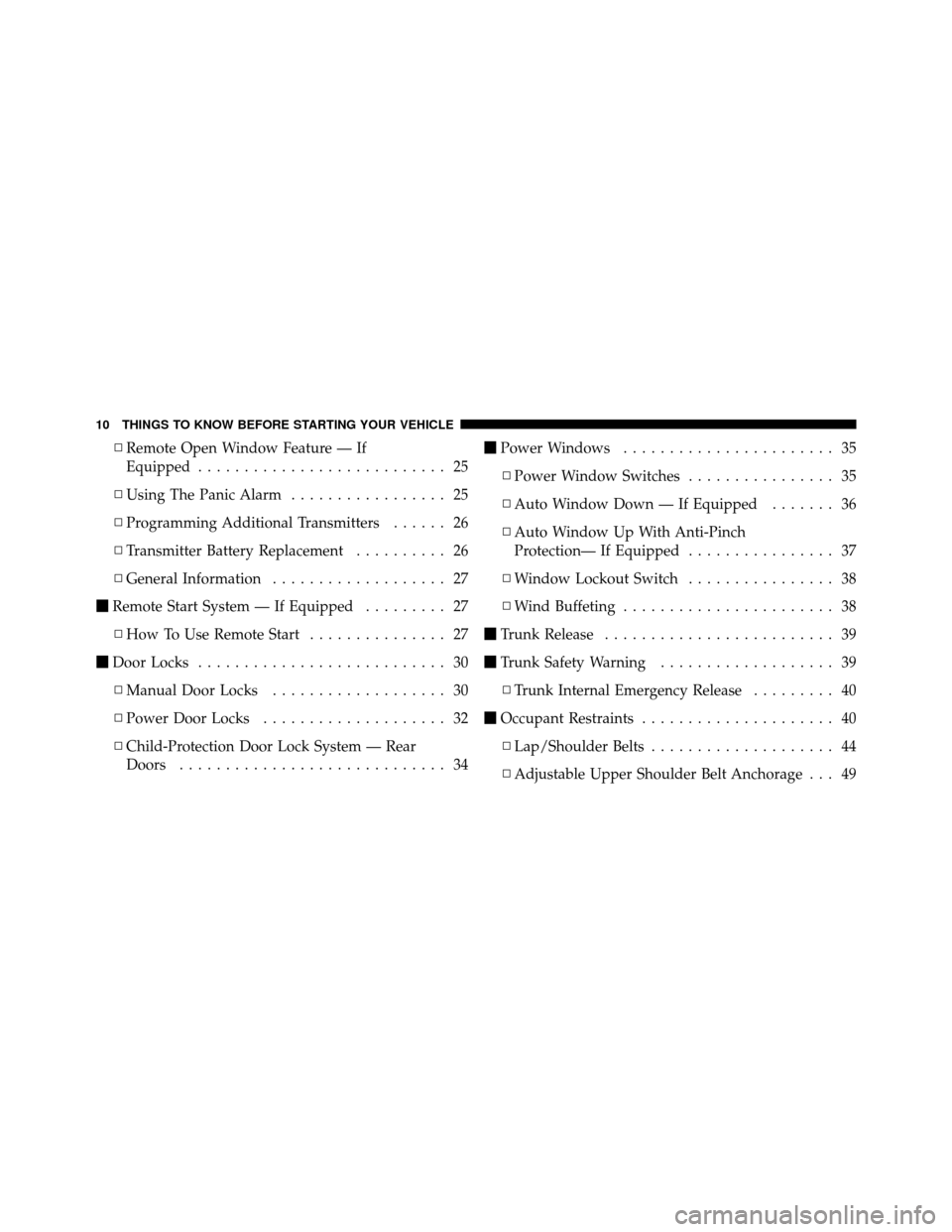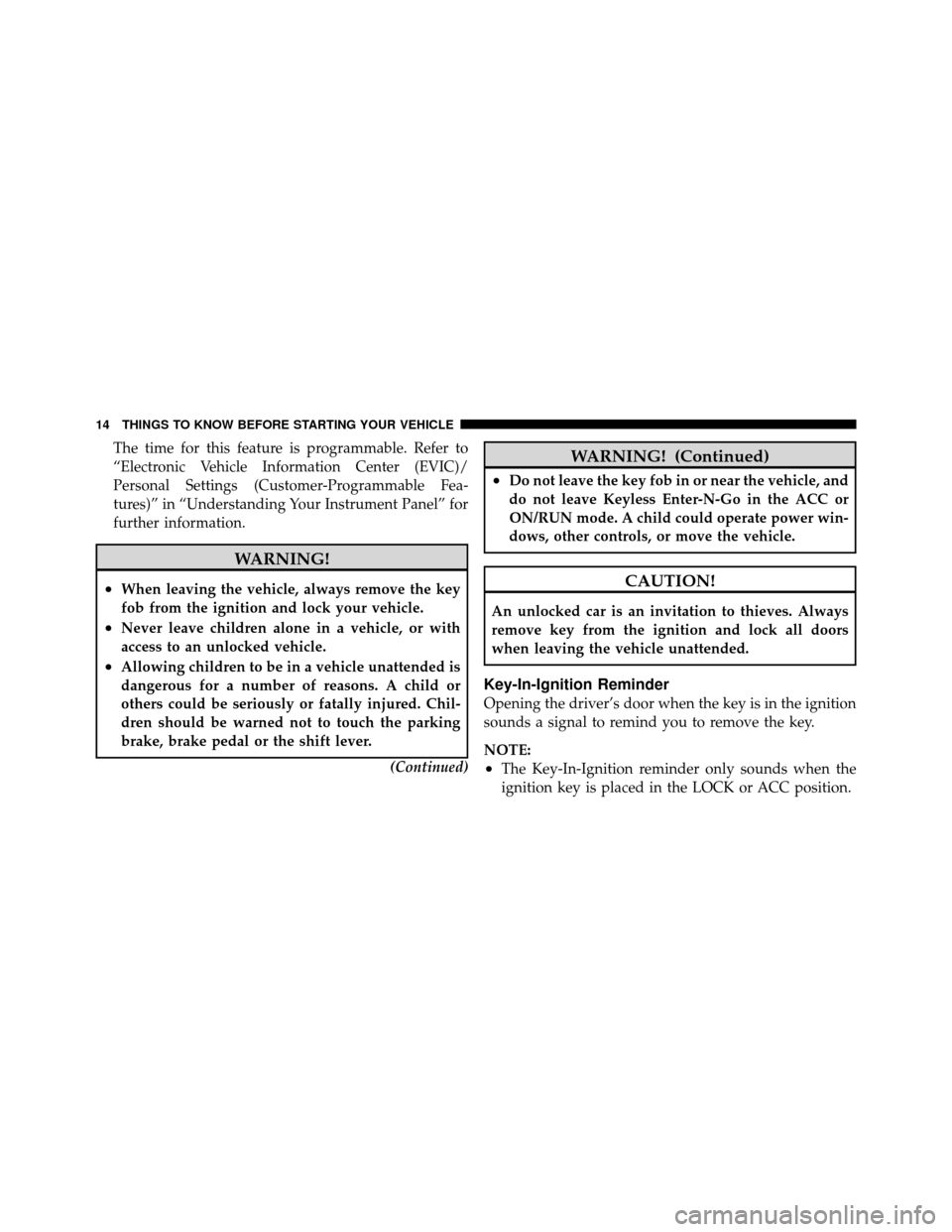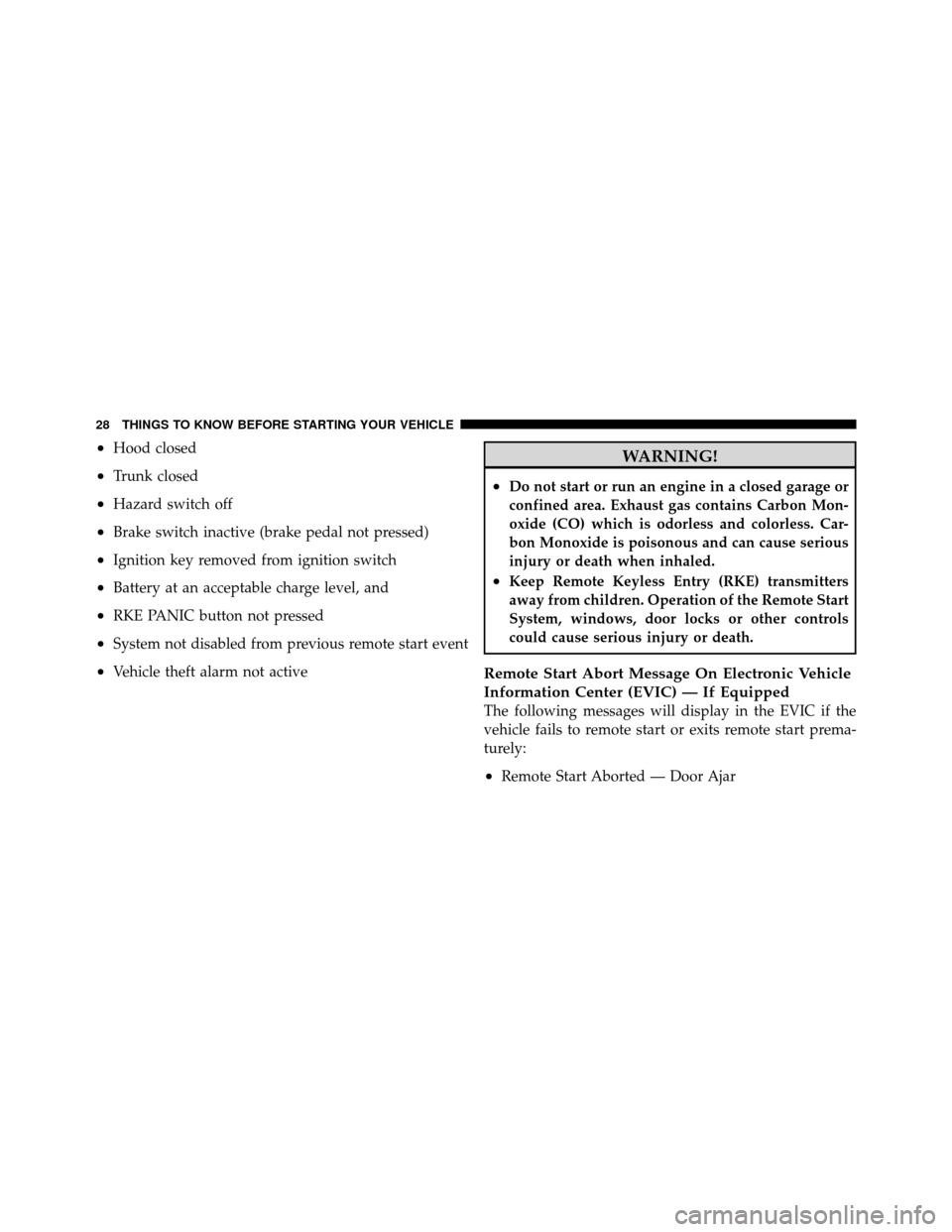Page 12 of 494

▫Remote Open Window Feature — If
Equipped ........................... 25
▫ Using The Panic Alarm ................. 25
▫ Programming Additional Transmitters ...... 26
▫ Transmitter Battery Replacement .......... 26
▫ General Information ................... 27
� Remote Start System — If Equipped ......... 27
▫ How To Use Remote Start ............... 27
� Door Locks ........................... 30
▫ Manual Door Locks ................... 30
▫ Power Door Locks .................... 32
▫ Child-Protection Door Lock System — Rear
Doors ............................. 34 �
Power Windows ....................... 35
▫ Power Window Switches ................ 35
▫ Auto Window Down — If Equipped ....... 36
▫ Auto Window Up With Anti-Pinch
Protection— If Equipped ................ 37
▫ Window Lockout Switch ................ 38
▫ Wind Buffeting ....................... 38
� Trunk Release ......................... 39
� Trunk Safety Warning ................... 39
▫ Trunk Internal Emergency Release ......... 40
� Occupant Restraints ..................... 40
▫ Lap/Shoulder Belts .................... 44
▫ Adjustable Upper Shoulder Belt Anchorage . . . 49
10 THINGS TO KNOW BEFORE STARTING YOUR VEHICLE
Page 13 of 494

▫Rear Seat Belts ....................... 50
▫ Seat Belts In Passenger Seating Positions ..... 50
▫ Automatic Locking Retractor Mode (ALR) —
If Equipped ......................... 50
▫ Energy Management Feature ............. 51
▫ Seat Belt Pretensioners ................. 52
▫ Supplemental Active Head Restraints (AHR)
— If Equipped ....................... 52
▫ Enhanced Seat Belt Use Reminder System
(BeltAlert�) ......................... 56
▫ BeltAlert� Programming ................ 57
▫ Seat Belts And Pregnant Women .......... 58
▫ Seat Belt Extender ..................... 58
▫ Supplemental Restraint System (SRS) — Air
Bags .............................. 58 ▫
Air Bag System Components ............. 60
▫ Advanced Front Air Bag Features .......... 61
▫ Air Bag Deployment Sensors And Controls . . . 64
▫ Event Data Recorder (EDR) .............. 71
▫ Child Restraints ...................... 72
� Engine Break-In Recommendations .......... 83
� Safety Tips ........................... 84
▫ Transporting Passengers ................ 84
▫ Exhaust Gas ......................... 85
▫ Safety Checks You Should Make Inside The
Vehicle ............................. 86
▫ Periodic Safety Checks You Should Make
Outside The Vehicle ................... 88
2
THINGS TO KNOW BEFORE STARTING YOUR VEHICLE 11
Page 16 of 494

The time for this feature is programmable. Refer to
“Electronic Vehicle Information Center (EVIC)/
Personal Settings (Customer-Programmable Fea-
tures)” in “Understanding Your Instrument Panel” for
further information.
WARNING!
•When leaving the vehicle, always remove the key
fob from the ignition and lock your vehicle.
•Never leave children alone in a vehicle, or with
access to an unlocked vehicle.
•Allowing children to be in a vehicle unattended is
dangerous for a number of reasons. A child or
others could be seriously or fatally injured. Chil-
dren should be warned not to touch the parking
brake, brake pedal or the shift lever.(Continued)
WARNING! (Continued)
•Do not leave the key fob in or near the vehicle, and
do not leave Keyless Enter-N-Go in the ACC or
ON/RUN mode. A child could operate power win-
dows, other controls, or move the vehicle.
CAUTION!
An unlocked car is an invitation to thieves. Always
remove key from the ignition and lock all doors
when leaving the vehicle unattended.
Key-In-Ignition Reminder
Opening the driver’s door when the key is in the ignition
sounds a signal to remind you to remove the key.
NOTE:
•The Key-In-Ignition reminder only sounds when the
ignition key is placed in the LOCK or ACC position.
14 THINGS TO KNOW BEFORE STARTING YOUR VEHICLE
Page 30 of 494

•Hood closed
•Trunk closed
•Hazard switch off
•Brake switch inactive (brake pedal not pressed)
•Ignition key removed from ignition switch
•Battery at an acceptable charge level, and
•RKE PANIC button not pressed
•System not disabled from previous remote start event
•Vehicle theft alarm not active
WARNING!
•Do not start or run an engine in a closed garage or
confined area. Exhaust gas contains Carbon Mon-
oxide (CO) which is odorless and colorless. Car-
bon Monoxide is poisonous and can cause serious
injury or death when inhaled.
•Keep Remote Keyless Entry (RKE) transmitters
away from children. Operation of the Remote Start
System, windows, door locks or other controls
could cause serious injury or death.
Remote Start Abort Message On Electronic Vehicle
Information Center (EVIC) — If Equipped
The following messages will display in the EVIC if the
vehicle fails to remote start or exits remote start prema-
turely:
•Remote Start Aborted — Door Ajar
28 THINGS TO KNOW BEFORE STARTING YOUR VEHICLE
Page 33 of 494

WARNING!
•For personal security and safety in the event of an
accident, lock the vehicle doors as you drive as
well as when you park and leave the vehicle.
•When leaving the vehicle, always remove the key
fob from the ignition and lock your vehicle.
•Never leave children alone in a vehicle, or with
access to an unlocked vehicle.
•Allowing children to be in a vehicle unattended is
dangerous for a number of reasons. A child or
others could be seriously or fatally injured. Chil-
dren should be warned not to touch the parking
brake, brake pedal or the shift lever.(Continued)
WARNING! (Continued)
•Do not leave the key fob in or near the vehicle, and
do not leave Keyless Enter-N-Go in the ACC or
ON/RUN mode. A child could operate power win-
dows, other controls, or move the vehicle.
CAUTION!
An unlocked vehicle is an invitation to thieves.
Always remove the key from the ignition and lock all
of the doors when leaving the vehicle unattended.
2
THINGS TO KNOW BEFORE STARTING YOUR VEHICLE 31
Page 36 of 494
Child-Protection Door Lock System — Rear
Doors
To provide a safer environment for children riding in the
rear seat, the rear doors of your vehicle have a Child-
Protection Door Lock system.The Child-Protection Door Locks are located inside the
rear edge of the door. Insert the tip of the ignition key or
similar flat-bladed object into the lock and rotate approxi-
mately one-quarter turn to the lock or unlock position (as
indicated by the stamped icons).
Child-Protection Door Lock LocationChild Lock Control
34 THINGS TO KNOW BEFORE STARTING YOUR VEHICLE
Page 37 of 494
WARNING!
Avoid trapping anyone in a vehicle in a collision.
Remember that the rear doors can only be opened
from the outside when the Child-Protection locks are
engaged.
NOTE: For emergency exit with the system engaged,
move the lock knob up (UNLOCKED position), roll
down the window, and open the door with the outside
door handle.
POWER WINDOWS
Power Window Switches
The control on the driver’s door has up/down switches
that give you fingertip control of all four power win-
dows. There is a single window control on the front and rear
passenger ’s door trim panel, which operates the front
and rear passenger door windows. The window controls
will operate when the ignition switch is turned to the
ON/RUN or ACC position, and when the accessory
delay feature is active.
AUTO Power Window Switch
2
THINGS TO KNOW BEFORE STARTING YOUR VEHICLE 35
Page 38 of 494

WARNING!
Never leave children in a vehicle, with the keys in
the ignition switch. Occupants, particularly unat-
tended children, can become entrapped by the win-
dows while operating the power window switches.
Such entrapment may result in serious injury or
death.
Auto Window Down — If Equipped
The front window controls on the driver and passenger
door trim panels have an Auto-Down feature. These
switches are labeled AUTO to indicate this capability.
Push the window switch past the first detent, release, and
the window will go down automatically.
To open the window part way, push the window switch
to the first detent and release it when you want the
window to stop.To cancel the Auto-Down movement, operate the switch
either in the up or down direction and release the switch.
For vehicles not equipped with the Electronic Vehicle
Information Center (EVIC), the power window switches
will remain active for 45 seconds after the ignition switch
is turned to the LOCK position. Opening either door will
cancel this feature.
For vehicles equipped with EVIC, the power window
switches will remain active for up to 10 minutes after the
ignition switch is turned off. Opening either door will
cancel this feature. The time for this feature is program-
mable. Refer to “Electronic Vehicle Information Center
(EVIC)/Personal Settings (Customer-Programmable Fea-
tures)” in “Understanding Your Instrument Panel” for
further information.
36 THINGS TO KNOW BEFORE STARTING YOUR VEHICLE